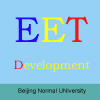-
Access for multiple disabilities
普通类 -
- 支持
- 批判
- 提问
- 解释
- 补充
- 删除
-
-
Assistive technology
EVERY STUDENT IS SPECIAL, although some learners may require special tools in order to help them learn more efficiently. Assistive technology has given way to a more well rounded approach to special education. With innovative technological devices and methods, learners have more choices. This article focuses on three types of learners who benefit from assistive technology devices.
-
Hard of hearing learners

Hard of hearing student and teacher using Audisee to enhance the student's educational experience
(photo courtesy of AudiSoft Technologies, Quebec, Canada)
Hard of hearing students may choose from several educational options, from schools for the deaf and hard of hearing where American Sign Language is the primary academic language, to full immersion in public institutions with access to interpreters and other state and federally funded programs and assistive devices.
Oralist students are learners with a hearing loss that communicate through spoken language and who usually have a cochlear implant or hearing aids. These students have access to assistive technology that provides access to the entire message, by combining their remaining hearing capabilities with visual cues.
The Audisee is such a device. The teacher wears a headset with a miniature camera and a microphone. The image and voice of the teacher is then transmitted to a small monitor placed on the student's desk or to a standard TV set placed in front of the classroom.
This gives hard of hearing students uninterrupted access to the teachers face and reduces background noise to give the learner complete access to what is being said in class.-
Visually impaired learners
Visually impaired learners have more access than ever to computer based programs. With the use of audio cues and visually enhanced screens (such as larger print), visually impaired learners can surf the web, use word processing programs and play computer games.
Products for visually impaired learners include:- screen readers or speech synthesizers that work with a multitude of software applications and the Internet;
- computer screens with magnification up to 16 times;
- and Braille translators that makes it easy to print a document for visually impaired readers

An exercise to help new users become acclimated to using the computer provides the student with audio cues as to the location of the mouse on the screen. Place the mouse somewhere on the gray part of the animated computer screen above. Close your eyes and try and find your way to the top left, top right, center, bottom left and bottom right areas of the screen.
-
Learning disabled
Despite adequate cognitive ability, learning disabled students often have difficulty with basic skills such as reading and writing. With the innovation of computer technology, assistive devices have provided the answer for many of these students. Learners can utilize these tools for instruction in school and as tools for life that can be used to compensate for specific impairments. A student with dysgraphia (i.e., inability to produce legible handwriting) can use a computer with a word-processing program to alleviate much of this problem. Students with severe problems in spelling can functionally compensate using spell checkers and on-line thesauruses. Word prediction programs that can anticipate words from a few letters can increase both accuracy and speed of input.
Below is an example of a multisensory approach for students with severe reading problems. Learners can use a computer in much the same way students with visual impairment do, through enlarged print size or voice synthesis. This provides the learner with the opportunity to use enhanced visual and audio cues to assist with reading comprehension.
-
More Information
Southwest Educational Department Laboratory
http://www.sedl.org/rural/seeds/assistivetech/atld.html
AudiSoft Technologies
http://www.sforh.com/communication/audisee.html
AbilityHub
http://www.abilityhub.com/vision/lowvision.htm-
Author
Lori Getz, Student
Getz, L. (2004). Assistive technology. In B. Hoffman (Ed.), Encyclopedia of Educational Technology. -
-
- 标签:
- disabilities
- access
- impaired
- student
- learners
- assistive
- multiple
- students
- hearing
- visually
- hard
- technology
-
加入的知识群:



学习元评论 (0条)
聪明如你,不妨在这 发表你的看法与心得 ~